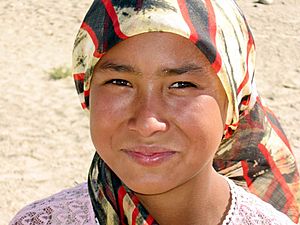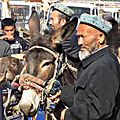Uyghur people facts for kids

Uyghur girl
|
|
| Regions with significant populations | |
|---|---|
(Xinjiang) |
11,303,355 |
| 223,100 (2009) | |
| 55,220 (2008) | |
| 49,000 (2009) | |
| 45,800 (2010) | |
| ~50,000 (2013) (Saudi Labor Ministry) | |
| ~3,500 (2015) (Uyghur Turkistan Islamic Party members plus families in Zanbaqi (الزنبقي) in Jisr al-Shughur) | |
(Uyghurs in Pakistan) |
~1,000 families (2010) |
| 3,696 (2010) | |
| 197 (2001) | |
| Languages | |
| Uyghur | |
| Religion | |
| Sunni Islam | |
| Related ethnic groups | |
| Uzbeks, other Turkic peoples and Tocharians | |
| This article contains Uyghur text. Without the correct software, you may see unjoined letters or other symbols instead of Uyghur script. |
The Uyghurs (wee-ger; 维吾尔人) are Chinese Turkic people living mainly in Xinjiang, China. Over 11 million Uyghurs live there, more than any other part of the world. Some Uyghurs seek independence from China.
Uyghurs also live in Beijing, Shanghai and Taoyuan County (Hunan, South-Central China). There are Uyghur diasporic communities in Turkey, Kazakhstan, Kyrgyzstan, Uzbekistan, Pakistan and Mongolia.
They are mainly Muslim and speak Uyghur, a Turkic language. They write in the Uyghur alphabet, which is based on the Arabic alphabet.
Uyghurs were originally from Mongolia and immigrated to Xinjiang during the 8th or 9th centuries AD. There they mixed with local Indo-European people.
Related pages
Images for kids
-
A Uyghur girde naan baker
-
Uyghur man in Kashgar
-
Chagatai Khanate (Moghulistan) in 1490
-
Map showing the distribution of ethnicities in Xinjiang according to census figures from 2000, the prefectures with Uyghur majorities are in blue.
-
Leaf from an Uyghur-Manichaean version of the ‘‘Arzhang’’.
See also
 In Spanish: Etnia uigur para niños
In Spanish: Etnia uigur para niños
















